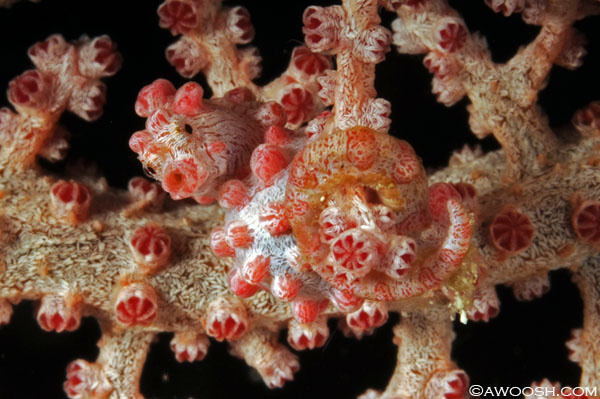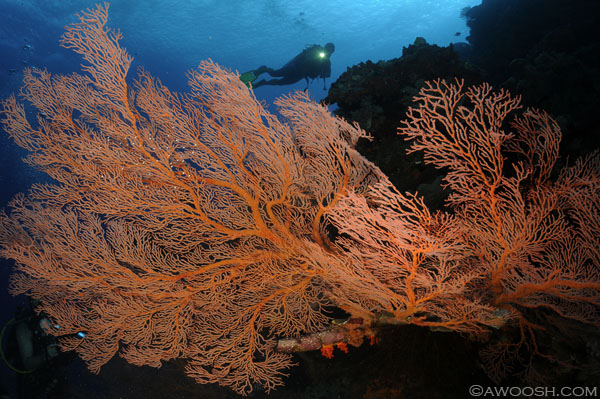Another day, another picture ;^)
While I am in the process of writing up the next of my fave destinations, I thought I’d throw another teaser out there.

Pygmy Seahorse – Hippocampus bargibanti
These little beauties are seriously tiny – this variety of Pygmy Seahorse (there are a few) is about the size of a grain of cooked whole grain rice.
I am going to confess right up front that there is not a chance of a snowball in hell that I would ever be able to find one of these little cuties with my own eyes. I suffer from (age onset) vision deterioration (can you say +5 prescription and still heading south? ;^). My opthamologist has suggested that a lot of reading in poor light, plus skiing and sun exposure without wearing protective lenses, all when I was young (and foolish), are the villains in my case.
My scuba mask has some diopters in it (about +2.5) that allow me to see my gauges and the big picture with reasonable clarity, but little things, and detail, are not viewable to me until I look through the adjusted diopter of my camera (thank you Nikon!) and then through my macro lens. I am not even going to get into how I focus on little stuff – I shoot manual focus when shooting Macro as I find it extremely frustrating to try to let the camera autofocus. The lens will whirr in and out, in and out, all the while chewing up battery power, and just when you think you have the focus locked, the subject (or you) will move and you have to start all over again. Another day I will describe my somewhat unorthodox, but surprisingly (to me) effective method of getting tiny subjects in focus.
Pygmy Seahorses have become popular subjects. They are just so darned cute. But they are also quite difficult to photograph well. There is nowhere to rest the camera, and care has to be taken, especially when shooting super macro, not to touch the sea fan with the camera. Needless to say, spot on buoyancy control is a must.
Typically, a guide will find these little guys. They know where and how to look for them – and it isn’t easy to spot them, even with good eyes, as they are typically well camouflaged (like the one pictured above).
The backdrop of the Pygmy image above is a sea fan. Pygmies attach themselves with their tails, and likely spend their entire life on one fan, just waiting for little delicacies to float by, which they hoover up with that funny little mouth.

Pygmies Live Here – a bit daunting to figure out exactly where…
A well-versed guide will use his pointer (aka muck stick) behind the fan, and point where the critter is. Looking through the viewfinder, it is easier to find the tip of the muck stick than the seahorse. Once you’ve got it in your camera sights, a grunt through the regulator lets the guide know you’ve got it framed up, and he or she will remove the stick. Point, pray, repeat.
Um, about that repeat? – It is very clear that the Pygmies are sensitive to strong lights – they appear startled and they turn their heads away from the camera as soon as the strobes are fired. I try to limit my shots to 3 or 4 max – one to fine tune exposure, one to (hopefully) get the shot I am looking for, and maybe a couple more as contingencies in case shot number two was not in sharp focus. I’ve seen other photographers camp over a Pygmy Seahorse for pretty much the duration of a dive, banging away on the shutter incessantly. Not cool, in my opinion.
There are actually two things that I think are not cool about this scenario – first (and foremost) – the well-being of the critter. And secondly, there will likely be several other photographers who are hoping to get a shot of the Pygmy. Subject-hogs become dive boat pariahs pretty quickly.
I should make a distinction though – it is my opinion that if you find the critter (whatever it might be), you should feel free to take your time, get your shots, and then kindly share the subject with other divers nearby (taking care not to splooge up the shot as you leave it).
If the guide finds the critter, then a different etiquette would seem to be in order – take a few shots (not more than a couple of minutes max – less if very deep and bottom time is an issue), and then move off (again, carefully, to avoid silting or displacing the subject) and let other waiting divers see it and/or take their pictures. You can always go to the back of the line and get another whack at it when everyone else has had their turn.
Like the divers camping over a Pygmy Sea Horse, I have seen divers camp over an interesting or rare subject which was initially spotted by a guide. They have to be aware that others are nearby, waiting – you can clearly hear the exhalation of people’s bubbles if they are somewhere close. A good guide will clue in to the situation, and gently tap the diver and motion to the others who are waiting to get a shot.
In one recent case, we were diving with a guide who was carrying a camera. I sh*t you not, I watched him take a hundred shots of another kind of Pygmy Sea Horse (with a little point and shoot that was unlikely to be capable of turning out the award-winning image he imagined himself bagging), while his clients waited in the periphery to get their turn. I gave up after ten minutes of watching him take pictures. It was kind of mind-boggling.
Anyhoo – a minor rant about diving and photographer etiquette.
By the way, please feel free to engage in a dialogue/leave comments about this or any other post on this blog. I am moderating the comments as you would not believe the quantity of spam that gets dumped here. To reply, you will need to leave your e.mail address. I can see it, but no one else can…

4 Responses to Pic of the Day – Pygmy Seahorse